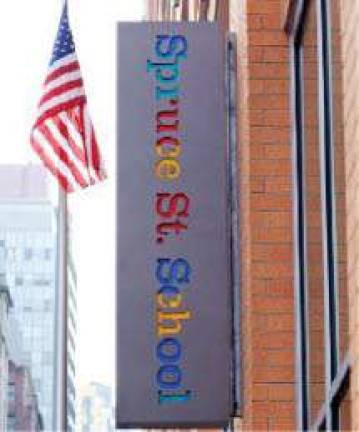School Overcrowding May be Contagious

The west side of lower Manhattan, plagued by over-packed public schools, should serve as a warning for the growing east side
Lower Manhattan Jostling for a seat at a public school in lower Manhattan has become as ingrained in city life as jostling for a seat on the subway, and the process is similar ? there's little one can do to ensure a seat but wait, hope and try to keep frustration and aggression at bay.
"The issue of overpopulation is going to continue to grow, there is no plan for real middle school growth in the downtown area," said Kristin Moshonas, a vice-president of the PTA for the Spruce Street School, P.S. 397, in the Financial District. The school currently serves pre-K through 5th grades. "When Spruce Street opened as one of the new schools downtown, it was already packed."
Moshonas is one of a number of parents who anxiously wait for the public school system to catch up to the number of kids in the district.
"It is sad that some families don't have a seat for their children, even if they live next door to a school," said Moshonas. "We are facing a challenging situation."
One of the problems is that the dense growth of downtown means that schools are often built into tightly-packed areas. Spruce Street School currently shares a plaza with a hospital and a parking lot. "It is not place for a school to be around those things, and the parking lot with cars constantly moving in and out is a danger to the young children," Moshonas said.
As the city and the Department of Education scramble to keep up with the demand for elementary and middle school seats in district 2 (which stretches from the Upper East Side, through midtown, and into the west side of lower Manhattan), many blame the current squeeze on a poor planning process that didn't properly adjust for the post-9/11 residential construction boom.
Shino Tanikawa, president of the Community Education Council for district 2, said that the city didn't use the metrics when calculating how many school seats would be needed for neighborhoods like Tribeca, Battery Park City, the West Village and the Financial District, all of which have seen big changes with new developments over the past decade.
"For these city projects, they were using outside contracts which looked at these problems according to areas marked out in city planning. The problem is that since the consultants are using the areas marked out for city planning, they do not line up with the actual areas they are supposed to be studying," Tanikawa said.
She said that consultants look at a district and calculate an average for the number of families, the growth of the neighborhood, how many will send their children to private school, but do not look at how these numbers can change on case by case basis depending on neighborhood.
"The city does not do the calculations well, or accurately. The system is flawed and doesn't work correctly on a neighborhood basis," said Tanikawa. "They don't look at the percentage of families which send their children to private school. They assume that the number will be about 30 percent, but in actuality one neighborhood could send around 60 percent, as is the case in some places downtown," and some could send a lower percentage.
The variants by neighborhood push the need for a more in-depth analysis of neighborhoods and populace, in order to correctly determine the need for school facilities in an area.
Schools elsewhere downtown are seeing similar overcrowding trends.
"I can't speak for elementary schools, but in middle schools there is a large growth of students in incoming classes," said Kelly McGuire, principal of the Lower Manhattan Community Middle School on Broadway near Beaver Street. "Classes are jumping from around 26 students to 30, 32."
McGuire said that she hears from parents who are nervous about class sizes becoming too big and negatively impacting students' abilities to learn.
"Parents are very concerned. The first question many ask is about class size. The problem is that large classes are now a standard in lower Manhattan," McGuire said. "There is a certain amount of space, we can't get more room from thin air."
Overcrowding is even an issue for local private schools. Gina Malin, director of school advisory services at The Parents League, a non profit association of parents and independent schools, said that she hears increasingly from parents who fear they won't be able to find a private school spot in their own neighborhood - sending a kid to private school nearby used to be a clear benefit to gambling with district placement that could send a student to another neighborhood.
"As population has increased tremendously, the spots are becoming tight," Malin said. "Parents are now looking at other neighborhoods, and have to travel with their children."
Some education advocates hope that all of this crunching on the west side of lower Manhattan will serve as a warning to the Department of Education to plan differently for the impending construction boom on the east side. On the Lower East Side, the city is developing a site formerly known as SPURA (Seward Park Urban Renewal Area) and now called Essex Crossing into a massive new neighborhood, complete with retail, office space and 1,000 residential apartments, half of which will be designated affordable for low-, moderate-and middle-income families. That means an influx of children, and hopefully, if the DOE takes the right actions, an influx of public school seats.